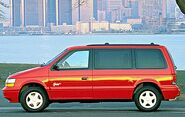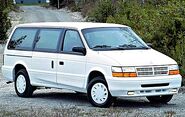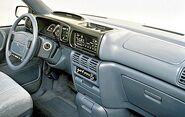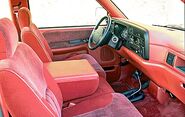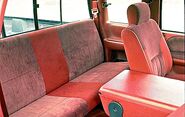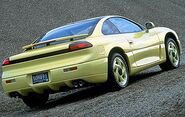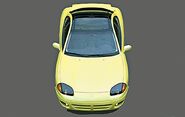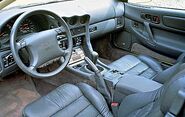Dodge Caravan/Grand Caravan
Under Chrysler Corporation's Dodge brand, the minivan was called the Dodge Caravan.
1991
The Dodge Caravan, along with its twin, the Plymouth Voyager, initiated the minivan phenomenon. Since its inception, the Caravan was the sales leader in the minivan category. Throughout its second generation, the Caravan was available in four trim levels: base, SE, LE and ES, in either standard size or the extended Grand Caravan.
1995
Since Dodge was looking forward to a complete makeover in 1996 for the front-drive Caravan, new features for the 1995 Dodge Caravan were limited to a series of minor enhancements. Chief among these included an optional refined 4-speed automatic transaxle and a revised remote keyless-entry system. Antilock brakes were now standard equipment on LE models, and engines fueled by compressed natural gas (CNG) were upgraded from limited production to a regular production option that anyone could order. Dodge also had realigned and upgraded equipment availability throughout the Caravan line.
Positioned right in the middle of the minivan market, the Dodge Caravan was designed for family-oriented buyers who prized versatility and a carlike ride. Key competitors included the Plymouth Voyager, Ford's rear-wheel-drive Aerostar, GMC's rear-drive Safari and Chevrolet's rear-drive Astro and front-drive Lumina.
The base engine remained the 2.5-liter inline 4-cylinder. Optional engines included the 3.0-liter sohc V6, a 3.3-liter V6 and the 3.8-liter V6. For 1995, the base transmission was a 3-speed automatic. A 4-speed automatic was optional. The 5-speed manual was dropped. The Caravan was also available with all-wheel drive.
1996
The feature most pertinent to the minivan is optimum use of imaginable space. To this end, the standard-wheelbase version of the redesigned 1996 Caravan is 3.6 in. shorter on the outside than the Mercury Villager, but provides 16% more cargo space on the inside. Companion priorities embrace ease of entry, seating packages and walk-through capability. The new Caravan addresses ease of entry by maintaining the same step-in seat height as previous models. To facilitate entry and exit using the original floor height, Dodge lowered the doorsills 1.4 in. To increase utility, the Caravan can be equipped with an optional driver-side sliding door.
Seats form the basis around which the new Caravan was designed. Their placement and form, especially the rear rows, directly affected underbody construction. Consumer clinics revealed that owners like to remove the seats to increase cargo room. So this concept was retained, allowing the removal of the center seat(s) while the rear one rolls forward on small wheels and folds up. All seats are removable without tools. Accessing the seats without leaving the vehicle is intended to be easier with an additional 1/2 in. of space between the front seats and quad-seating placement.
Caravan buyers can choose from a plethora of models and trim lines, all of which offer dual-airbag protection, antilock brakes and childproof door locks. Body rigidity for the 4-door version is 50% greater than it was for the prior 3-door configuration, and the familiar MacPherson strut front suspension and tube axle/leaf spring rear suspension have been retained. Vehicle track is wider now, reducing the diameter of the turning circle by nearly 3.5 ft. Base power comes from the 2.4-liter dohc engine also found in the Cirrus and Stratus sedans.
Dodge Colt
The Dodge Colt was a subcompact car sold from the 1970s to 1994.
1991
In 1991, there were three models -- the base and GL 2-door hatchbacks, and a Vista 4-door station wagon.
1992
The Vista wagon was discontinued as of 1992, leaving behind just the 2-door hatchbacks.
1993
A new 4-door sedan was introduced, also in base and GL models.
1994
In the Dodge Colt's last model year, the lineup now consisted of a 2-door coupe and a 4-door sedan, both each in base and ES models.
Dodge Dakota
As the first and only so-called midsize pickup, the Dodge Dakota had the field all to itself.
1991
The Dakota was available in a choice of three wheelbases and two cab styles: regular and extended, which was called the Club Cab. In addition, the Dakota came in 2-wheel or 4-wheel drive. There were three trim levels -- Work, Sport, Base. The base engine was a 99-horsepower 2.5-liter inline 4-cylinder. A 5-speed manual transmission was standard. A 4-speed automatic overdrive was optional. The 4wd models featured a 2-speed transfer case with a floor-mounted shift lever and automatic locking hubs for shift-on-the-fly 4wd operation.
1992
Two new engines debuted: a 3.9-liter V6 with 180 horsepower and 5.2-liter V8 with 230 horsepower.
1993
4-wheel antilock braking was built in on all 1993 Dakotas.
1994
Positioned as the largest of the compact trucks, the Dodge Dakota was designed to appeal to buyers who would feel cramped in a compact pickup but also put off by the bulk of a full-size pickup. Although there were no other midsize pickups, key competition for the Dakota was provided by the slightly smaller Ford Ranger and Chevrolet S-10, and the even larger Toyota T100, which was not quite full-size.
Two new trim levels were made available: Special SLT (standard cab) and Super SLT (Club Cab). In addition, the 3.9-liter Magnum V6 engine and the 5.2-liter V8, also bearing the "Magnum" nameplate, were both downgraded by 5 hp.
1995
For 1995, the Dakota remained the same on the outside but benefited from modest changes under the hood and in the cab. New this year were a clutch-starter interlock with the standard manual transmission, an upgraded sound system and a modified front bench seat. Also new was an optional V8 engine powered by compressed natural gas (CNG).
1996
A new 2.5-liter 120-hp engine debuted for the base Regular Cab pickup truck.
Dodge Daytona
1991
In the early 1990s, the Dodge Daytona was sold as Dodge's front-wheel-drive 2-door hatchback. There were four models -- base, ES, IROC and Shelby.
1992
The Shelby was discontinued in 1992, and production for the 1992 model year was moved to Sterling Heights, Michigan. Replacing the Shelby was a new IROC R/T Turbo.
1993
After the Daytona permanently ended production early in 1993, the car was replaced by the Dodge Avenger more than a year later.
Dodge Dynasty
1991
Dodge's mid-size front-wheel-drive 4-door sedan was sold as the Dodge Dynasty. It was related to the Chrysler New Yorker. There were two models sold -- base and LE.
1993
After 1993, the Dodge Dynasty ended production.
Dodge Monaco/Intrepid
1991
One of Dodge's full-size 4-door sedans, the Monaco, was available in ES and LE models.
1992
Due to a market failure, the Monaco was discontinued after the 1992 model year and was replaced by the Dodge Intrepid.
1993
Introduced in 1993, the Intrepid is part of Chrysler's LH-car trio, which also includes the sporty Eagle Vision and the luxurious Chrysler Concorde. While the Dodge shares many mechanical components with its sister vehicles, it's aimed at the competitive midsize family sedan market, where it sells against such other front-wheel drive 4-doors as the Ford Taurus, Honda Accord, Nissan Maxima, Toyota Camry and Pontiac's Grand Prix and Bonneville. While most of its competitors are midsize cars, Chrysler's unique "cab-forward" design creates enough interior volume for the EPA to classify the Intrepid as a Large Car. The Intrepid is intended to appeal to a wide range of buyers with a common interest: finding a modestly priced 4-door sedan big enough to carry a family in comfort. Two trim levels are offered: Base and ES. Both feature a 3.3-liter 161-hp ohv V6 engine. Optional powerplant is a 3.5-liter 24-valve 214-hp sohc V6. Both drive through an electronically-controlled 4-speed automatic transaxle that's been refined for 1995. A flexible-fuel 3.3-liter engine is available in California only. It can run on 100% gasoline, an 85%/15% methanol/gasoline mixture (M-85), or any combination of the two. Standard equipment includes dual airbags, AM/FM/cassette stereo, air conditioning, speed-sensitive power steering, childproof rear door locks, tinted glass, courtesy lights, power mirrors, rear-window defroster, tilt steering wheel and power windows. The ES adds 4-wheel disc ABS (optional on the base model) and power door locks. Options include traction control, power moonroof, bench front seat and an integral child safety seat.
Dodge Ram (Pickup)
1991
There were four trim levels for the Dodge Ram 50: Short and Long Bed versions of both each the base and SE pickup trucks. In addition, there was also a 2-door SUV called the Ramcharger 150. Accompanying this car was a 150S.
1994
In 1994, the all-new Dodge Ram made an impressive debut, breaking styling rules left and right. The new design clearly set the Ram apart from the rest of the pack in the full-size pickup truck market.
1995
For 1995, Dodge introduces a full line of Club Cab models, which add 20 inches to the Ram cab and hold six passengers in a split 40/20/40 front bench seat and a full rear bench. Other significant option changes this year include a V8 engine powered by compressed natural gas (CNG), 4-wheel antilock brakes for 1-ton models (late availability), revised sport package (also later in the year), and an upgraded sound system. Also new this year is an illuminated overdrive lockout switch. Positioned in the heart of the full-size pickup truck market, the Dodge Ram is designed for buyers who need a big, durable pickup for work or play, but who want it in a modern aerodynamic package with styling flair. Prime competition comes from the Ford F-Series, Chevrolet C/K and GMC Sierra full-size trucks. The Dodge Ram is available in regular cab and extended cab (Club Cab) models in three series, 1/2-ton (1500), 3/4-ton (2500) and 1-ton (3500), in 2-wheel-drive and 4-wheel-drive versions. There are four trim levels: LT, Work Special, ST and Laramie SLT. The base engine is a 3.9-liter ohv V6. Optional engines include a 5.2-liter ohv V8 (gas and CNG), a 5.9-liter ohv V8, a 5.9-liter inline 6-cylinder turbodiesel and the super-hot 8.0-liter V10. A 5-speed manual transmission is standard. Light-duty and heavy-duty 4-speed automatics are optional.
Dodge Ram (Van)
1991
Chrysler Corporation's full-size vans under the Dodge brand, the Ram Van and the Ram Wagon, were available in B150 and B250 models. The B150 was available in Cargo Long, Cargo Short, Window Long and Window Short Wheelbase trim levels, while the B250 also included Maxivan and Maxiwagon Long Wheelbase vans, but no Window Short Wheelbase van.
As the Dodge Ram Wagon and Van inch toward the quarter-century mark, Dodge continues to invest in these full-size stalwarts. The 1995 enhancements are designed to keep the van current until it receives a complete and well-deserved revamping some time down the road. This year, a standard driver's airbag and 4-wheel antilock brakes come on board the Wagon. Also new are an optional upgraded sound system, power driver's seat, chrome-styled steel wheels and overhead courtesy/map lights. A brand-new standard feature throughout the line is an underseat passenger-side storage drawer. In addition, the sliding door mechanism has been refined. Like the other full-size vans on the market, the Dodge Ram Wagon and Van have always appealed to no-nonsense buyers who expect maximum power and flexibility for people-ferrying and cargo-carrying operations. Key competitors include GMC Rally Van, Ford Club Wagon and Chevrolet Sportvan. The Dodge Ram is available as a passenger Wagon or a cargo Van in one of three newly revised model designations: 1500, 2500 and 3500. In addition, two wheelbases and lengths are available in four different trim levels. Ram Vans also have the lowest load floor height in their class. The base engine for the Ram Wagon remains the 3.9-liter V6. The optional engines are a 5.2-liter V8 and a 5.9-liter V8, which gives the Wagon a towing rating of up to 8800 pounds. The base transmission is a 3-speed automatic, and a 4-speed automatic is available as an option.
Dodge Shadow
1991
Dodge's early compact car, the Shadow, was available as a 2-door convertible (ES and Highline), and 2-door and 4-door hatchbacks (America, ES and Highline).
1992
The ES models were upgraded to contain 3.0-liter engines.
1993
The America and Highline models were discontinued, and in their place were base versions of all three vehicles.
1994
The convertible was removed from the lineup, leaving behind the base and ES 2-door and 4-door hatchbacks.
Dodge Spirit
1991
The Spirit was a midsize sedan that provided 6 seats and 4 doors in a conservatively-styled front-wheel drive package and included a generous list of standard equipment at a comparatively low price. The Spirit competed with the Ford Mondeo, the Chevrolet Corsica and its corporate twin, the Plymouth Acclaim. It was available with four trim models: base, ES, LE and R/T Turbo.
1992
New for 1992 were revised gear ratios for the R/T Turbo, and the LE received 3-speed automatic transmission.
1993
The 1993 Spirit had two trim levels: Highline and ES.
1994
As of 1994, there was only one trim level, and a choice of two engines, which made ordering the Spirit a lot simpler than some other models. The standard powerplant was a 100-hp, 2.5-liter 4-cylinder. The optional engine was a 142-hp 3.0-liter single-overhead-cam V6. Both engines drove the front wheels through a 3-speed automatic transaxle. This was the last model year for 4-speed automatic transmission and the optional fold-down rear seatbacks.
Standard equipment included a driver's airbag, air conditioning, rear-window defroster, floor mats, tinted glass, remote-control outside mirrors, 4-speaker AM/FM/cassette sound system, cruise control and tilt steering wheel. Options (aside from the V6 engine) included ABS, power locks/windows/seats/mirrors and a "gold option package" that included cast-aluminum wheels with gold accents, a luggage rack, one-size-larger tires, body side moldings with a gold stripe, body-color fascias with gold accents and special gold decals. The standard seating arrangement was a 50/50 split front bench with folding arm rests and dual recliners.
1995
The introduction of the new Dodge Stratus marked the last year for the practical but aging Dodge Spirit. It was one step up from the new Dodge Neon in both exterior size and price. For this model year, the 50/50 split rear bench seat was fixed, and the antilock brakes were removed.
Dodge Stealth
The Stealth sports car was a twin under the skin to the Mitsubishi 3000GT. Built by Chrysler's partner Mitsubishi in Japan, the Stealth sported Chrysler-designed bodywork over the Mitsubishi chassis and drivetrain. It was a high-tech, high-performance sports car that competed with the Chevrolet Corvette, Mazda RX-7, Nissan 300ZX, Toyota Supra and the 3000GT itself.
1991
In 1991, four models were available -- Base, ES, R/T and R/T Turbo -- that provided increasing sophistication and performance at increasing prices. The Base version was a front-wheel drive model powered by a 3.0-liter sohc 12-valve V6 that produced 164 hp. The ES and R/T, were also front-wheel drive cars with a 3.0-liter dohc 24-valve V6 that delivered 222 hp. A 5-speed manual transaxle was standard with both of these engines; a 4-speed automatic was optional. Finally, there was the R/T Turbo, with 300 horsepower and 5-speed manual transmission. ABS was standard on the R/T Turbo and optional on the other models.
1992
New for 1992 was a glass sunroof.
1993
This was the last model year for the Dodge Stealth ES.
1994
A new version of the twin-turbo version of the dohc engine with 320 hp propelled the Stealth R/T Turbo model from 0 to 60 mph in a breath-taking 5.3 seconds. The only drivetrain available with this engine was a 6-speed manual transmission with all-wheel drive.
1995
Standard features on all models included dual airbags, rear-window defroster, spoiler, power outside rearview mirrors, AM/FM/cassette stereo system, and a leather-wrapped tilt steering wheel. Base and R/T models had 15-in. wheels; the Turbo had 17-inchers. New for '95 were optional 18-in. chrome wheels. The main differences between the Stealth and 3000GT, aside from the styling, were the GT's movable aerodynamic aids and a retractable hardtop convertible model.
1996
The last of the Dodge Stealths got a new body color spolier and leather front seats.
Dodge Viper
The Viper RT/10 is the ultimate hotrod, brutally fast and brutal to drive. It's a no-holds-barred race car for the street, demanding both skill and endurance from its driver. It's really in a class by itself, its closest competition being the more civilized (imagine that!) Corvette ZR-1. Porsches and Ferraris are simply too refined to be considered in the same league. The Viper sports the biggest engine on the road, this side of an 18-wheeler, a 400-hp all-aluminum 8.0-liter V10 that can propel the 2-seat roadster from 0 to 60 mph in a mere 4.5 seconds. A Viper has been timed from 0 to 100 and back to 0 again in less than 14.8 seconds, showing that its massive disc brakes and huge, steam-roller tires are as powerful as its V10. Those brakes are not available with ABS, putting a premium on driver skill. Because it can spin its rear wheels at almost any speed, much delicacy is required on the gas pedal as well. The car is a 2-seat roadster. It has removable side curtains in place of roll-up windows and a primitive folding top that should require a building permit to erect, no Mercedes-like one-button operation here! It's basically a fair-weather toy for the person who needs to own the fastest car in town. The only option available is air conditioning, which is probably superfluous in a convertible with a top you never want to put up. The only available transmission is a 6-speed manual. Like most high-performance cars, the Viper has rear-wheel drive. The '95 model is pretty much a carryover. It's now available in green and yellow, as well as the original red. A coupe is expected in 1996.
Dodge Neon
The Neon, Chrysler's new small car, was introduced in January of 1994 as a '95 model. Like several recent new products from Chrysler, the Neon is a unique vehicle in its class. It sells against such other sub-compact family cars as the identical Plymouth Neon, the Chevrolet Cavalier, Ford Escort, Saturn SL, Toyota Corolla and Tercel, Nissan Sentra, Honda Civic, and numerous other small Asian imports. The Neon has standard dual airbags plus optional ABS brakes and a built-in child safety seat. It's fairly large for a small car, rather wide, with the longest wheelbase in its class, giving it an unusually large amount of rear seat legroom. Being bigger than most small cars, it has bigger doors, which makes entry and exit easier. It also has one of the biggest, most powerful engines in the small car class, a 2-liter, overhead-cam 16-valve Four that develops 132 hp. An optional dohc version of the same engine develops 150 hp. The standard transmission is a 5-speed manual. A 3-speed automatic is optional. There are three trim levels, Base, Highline and Sport. The Base model is the price leader, and is fairly Spartan, having a manual transmission but no tachometer. The Highline models include more standard equipment, and Sport models are available with the more powerful twin-cam engine. Options are offered in some 2-dozen packages, or individually. A 4-door sedan was the original model. A sportier 2-door coupe is the latest entry, and it is not available in base trim. Thoughtful standard features include molded-in change- and cupholders on the center console, sliding extensions on the sun visors with built-in map holders and a pencil-holder inside the glove box door.
Dodge Avenger
The Avenger is Dodge’s version of the Chrysler Sebring 2-door sport coupe. While the Sebring accents luxury, the Dodge emphasizes sporty performance.
Avenger replaces the Dodge Daytona sport coupe, which was dropped a couple of years ago. It competes with the not-quite-identical Chrysler Sebring as well as the Eagle Talon, Mitsubishi Eclipse, Ford Probe, Mazda MX-6, Nissan 240SX and Toyota Celica compact sport coupes. It represents the entry-level of Dodge’s performance lineup, which also includes the Stealth and Viper. It’s aimed at the sport coupe buyer who wants comfort as well as style, spirited driving and affordability. The Avenger has more interior room than the average small sport coupe. Typical buyers are expected to be single or young couples without children.
Two models are available. The base model is powered by a Chrysler-built 140-horsepower 2.0-liter 16-valve dohc 4-cylinder engine. Standard transmission is a 5-speed manual. A 4-speed automatic is optional. The ES model is powered by a 155-horsepower 2.5-liter 24-valve sohc V6, mated to the automatic transmission. Standard equipment on both models includes 4-wheel independent suspension, dual airbags, speed-sensitive power steering, tinted glass, rear-window defroster, AM/FM stereo, tilt steering wheel, bucket seats, a center console and split folding rear seatbacks that lock in the upright position. ES models add standard AM/FM/cassette stereo, rear decklid spoiler, 16-in. tires and aluminum wheels, leather-wrapped steering wheel, floor mats, trunk cargo nets, cruise control and 4-wheel disc ABS.
Dodge Stratus
Chrysler Corporation's so-called "cloud cars" are the Dodge Stratus and the similar Chrysler Cirrus. Dodge's sporty version competes in the tough front-wheel drive compact sedan market with the Honda Accord, Nissan Altima, Ford Contour, Pontiac Grand Am and Toyota Camry. The Stratus is positioned right in the center of this market. It's the only sedan in the group to take advantage of Chrysler's "cab-forward" design, which allows more interior room and trunk space than most of its competitors.
Stratus will replace the aging Dodge Spirit/Plymouth Acclaim twins when they are discontinued at the end of this model year. It's also aimed at a customer who would ordinarily consider an import before a domestic car. To appeal to this "import-intender" customer, the design team focused on the five features these buyers said they look for, styling, packaging of comfort and convenience features, safety, dependability and a fun-to-drive feel. The Stratus is a 5-passenger sedan with front bucket seats. It has the most rear-seat legroom and the largest trunk in its class. The trunk ha s a lockable pass-through, full-folding rear seats and a remote trunk release.
Two trim levels and three engines are available. Base engine is a 132-hp 2.0-liter sohc 16-valve 4-cylinder. In December, a 140-hp 2.4-liter dohc 16-valve Four will enter production. Top-of-the-line engine is a 164-hp 2.5-liter 24-valve sohc V6. A 5-speed manual transaxle is standard on the 2.0-liter engine. A 4-speed automatic comes with the 2.4-liter Four and 2.5-liter V6.
